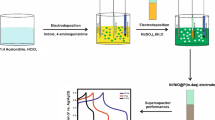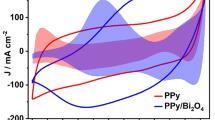Abstract
To unleash the crude potential of polyindole (PIN), it is necessary to modify the polymerization technique in a way that a purer form of PIN is obtained with minimal pre- and post-processing. This work emphasizes the chemical oxidative polymerization of indole in the presence of a hydrotrope–tetra n-octyl ammonium bromide (TOAB), which acts as a phase transfer catalyst and encapsulating agent. The inclusion of TOAB resulted in a fine and uniform morphology of PIN with an average diameter of up to ± 100 nm. In addition, the physicochemical properties were analysed using X-ray diffraction and were in line with FESEM and FTIR analysis. The conjugated activity was also distinguished using UV–Vis. Furthermore, the synthesized PIN was also subjected to an electrochemical study, resulting in a higher specific capacitance in order of two or three magnitudes than those synthesized in the presence of a complete or partial organic solvent, or surfactants. To approve these results, a simple asymmetric supercapacitor was fabricated using as-synthesized PIN and activated carbon as electrode material to power electrical watch. The fabricated low-power energy storage device was able to keep the electronic watch on for more than 240 s, attesting the superior charge transfer and ion mobility. Hence, this work offers a new approach to synthesize PIN as binder-free electrode in aqueous mode and demonstrates a promising potential in several energy storage applications.












Similar content being viewed by others
Abbreviations
- R s :
-
Solution resistance (Ohm)
- R ct :
-
Charge transfer resistance (Ohm)
- T :
-
Temperature (K)
- t :
-
Time (h)
References
Akiba H, Ohmura R (2016) Surface tension between CO2 gas and tetra-n- butylammonium bromide aqueous solution. J Chem Thermodyn 92:72–75. https://doi.org/10.1016/j.jct.2015.08.039
An S, Abdiryim T, Ding Y, Nurulla I (2008) A comparative study of the microemulsion and interfacial polymerization for polyindole. Mater Lett 62(6):935–938. https://doi.org/10.1016/j.matlet.2007.07.014
Arjomandi J, Nematollahi D, Amani A (2014) Enhanced electrical conductivity of polyindole prepared by electrochemical polymerization of indole in ionic liquids. J Appl Polym Sci 131(8):40094. https://doi.org/10.1002/app.40094
Bauduin P, Renoncourt A, Kopf A, Touraud D, Kunz W (2005) Unified concept of solubilization in water by hydrotropes and cosolvents. Langmuir 21(15):6769–6775. https://doi.org/10.1021/la050554l
Berkes BB, Bandarenka AS, Inzelt G (2015) Electropolymerization: further insight into the formation of conducting polyindole thin films. J Phys Chem C 119(4):1996–2003. https://doi.org/10.1021/jp512208s
Çakar S, Soykan C, Özacar M (2021) Polyacrylonitrile/polyindole and poly(glycidyl methacrylate)/polyindole composites based quasi solid electrolyte materials for dye sensitized solar cells. Sol Energy 215:157–168. https://doi.org/10.1016/j.solener.2020.12.039
Carles S, Desfrançois C, Schermann JP, Smith DMA, Adamowicz L (2000) Structures and electron affinities of indole–(water)N clusters. J Chem Phys 112(8):3726–3734. https://doi.org/10.1063/1.480938
Cheng Y, Hall DM, Boualavong J, Hickey RJ, Lvov SN, Gorski CA (2021) Influence of hydrotropes on the solubilities and diffusivities of redox-active organic compounds for aqueous flow batteries. ACS Omega 6(45):30800–30810. https://doi.org/10.1021/acsomega.1c05133
Choi KM, Kim CY, Kim KH (1992a) Polymerization mechanism and physicochemical properties of electrochemically prepared polyindole tetrafluoroborate. J Phys Chem 96(9):3782–3788. https://doi.org/10.1021/j100188a040
Choi KM, Jang JH, Rhee H-W, Kim KH (1992b) A study of polyindole perchlorate (PIP) prepared by electropolymerization. J Appl Polym Sci 46(10):1695–1706. https://doi.org/10.1002/app.1992.070461001
Costa MBG, Juarez JM, Martinez ML, Cussa J, Anunziata OA (2012) Synthesis and characterization of a novel composite: polyindole included in nanostructureed Al-MCM-41 material. Microporous Mesoporous Mater 153:191–197. https://doi.org/10.1016/j.micromeso.2011.12.044
Choudhary RB, Majumder M, Thakur AK (2019) Two-Dimensional exfoliated MoS2 flakes integrated with polyindole for supercapacitor application. ChemistrySelect 4(23):6906–6912. https://doi.org/10.1002/slct.201901558
Dou X, Wang X, Qian S, Liu N, Yuan X (2020) From understanding the roles of tetraoctylammonium bromide in the two-phase brust-schiffrin method to tuning the size of gold nanoclusters. Nanoscale 12(38):19855–19860. https://doi.org/10.1039/D0NR04439C
Elango M, Deepa M, Subramanian R, Musthafa AM (2017) Synthesis, characterization of polyindole/agzno nanocomposites and its antibacterial activity. J Alloys Compd 696:391–401. https://doi.org/10.1016/j.jallcom.2016.11.258
Espinoza EM, Clark JA, Soliman J, Derr JB, Morales M, Vullev VI (2019) Practical aspects of cyclic voltammetry: how to estimate reduction potentials when irreversibility prevails. J Electrochem Soc 166(5):H3175. https://doi.org/10.1149/2.0241905jes
Fañanás FJ, Granados A, Sanz R, Ignacio JM, Barluenga J (2001) Synthesis of functionalized pyrrole and indole derivatives through carbometallation of lithiated double bonds. Chem Eur J 7(13):2896–2907. https://doi.org/10.1002/1521-3765(20010702)7:13%3c2896::AID-CHEM2896%3e3.0.CO;2-R
Ghosh D, Giri S, Moniruzzaman M, Basu T, Mandal M, Das CK (2014) α MnMoO4/graphene hybrid composite: high energy density supercapacitor electrode material. Dalton Trans 43(28):11067–11076. https://doi.org/10.1039/C4DT00672K
Goel S, Mazumdar NA, Gupta A (2010) Fabrication of polyindene and polyindole nanostructures. Appl Surf Sci 256(14):4426–4433. https://doi.org/10.1016/j.apsusc.2010.01.010
Gong Y, Kato K, Kimoto H (2000) Crystal structure of diethyl 2–222- trifluoro-1-indole-3-yl-ethyl-2-acetamidomalonate. Cryst Res Technol 35(1):133–137. https://doi.org/10.1002/(SICI)1521-4079(200001)35:1%3c133::AID-CRAT133%3e3.0.CO;2-4
Gupta B, Chauhan DS, Prakash R (2010) Controlled morphology of conducting polymers: formation of nanorods and microspheres of polyindole. Mater Chem Phys 120(2):625–630. https://doi.org/10.1016/j.matchemphys.2009.12.026
Jordan A, Stoy P, Sneddon HF (2021) Chlorinated solvents: their advantages, disadvantages, and alternatives in organic and medicinal chemistry. Chem Rev 121(3):1582–1622. https://doi.org/10.1021/acs.chemrev.0c00709
Kabir-ud-Din, Parveen N, Naqvi AZ (2009) Hydrotropic behavior of sodium salicylate in presence of additives. J. Dispers. Sci. Technol. 30(10):1500–1505. https://doi.org/10.1080/01932690903123437
Kanan K, Yousef H, Kayali I (2012) Nanostructured microemulsion phase behavior using AOT or extended surfactant combined with a cationic hydrotrope. J Surf Eng Mater Adv Technol 2(1):53–60. https://doi.org/10.4236/jsemat.2012.21010
Kanan K, Al-Jabari M, Kayali I (2017) Phase behavioral changes in SDS association structures induced by cationic hydrotropes. Arab J Chem 10:S314–S320. https://doi.org/10.1016/j.arabjc.2012.08.003
Karami H, Nezhad A (2013) Investigation of pulse-electropolymerization of conductive polypyrrole nanostructures. Int J Electrochem Sci 8(6):8905–8921
Khurana JM, Kumar S (2009) Tetrabutylammonium Bromide (TBAB): a neutral and efficient catalyst for the synthesis of biscoumarin and 3,4- dihydropyrano[c]chromene derivatives in water and solvent-free conditions. Tetrahedron Lett 50(28):4125–4127. https://doi.org/10.1016/j.tetlet.2009.04.125
Laronze M, Laronze J-Y, Nemes C, Sapi J (1999) Oxidative transformation of indole-3-acetonitrile derivatives into the corresponding indole-3-carboxylic acids. Eur J Org Chem 1999(9):2285–2291. https://doi.org/10.1002/(SICI)1099-0690(199909)1999:9%3c2285::AID-EJOC2285%3e3.0.CO;2-N
Li P, Wong KL, Kwan MCY, Tsang CW, Pang SF (1996) Evaluation of fluorinated indole derivatives for electron-capture negative ionization mass spectrometry: application to the measurement of endogenous 5-methoxyindole-3-acetic acid in rat. J Mass Spectrom 31(11):1228–1236. https://doi.org/10.1002/(SICI)1096-9888(199611)31:11%3c1228::AID-JMS411%3e3.0.CO;2-1
Liu W-W, Feng Y-Q, Yan X-B, Chen J-T, Xue Q-J (2013) Superior micro- supercapacitors based on graphene quantum dots. Adv Funct Mater 23(33):4111–4122. https://doi.org/10.1002/adfm.201203771
Ma X, Zhou W, Mo D, Lu B, Jiang F, Xu J (2014) One-step template-free electrodeposition of novel poly(indole-7-carboxylic acid) nanowires and their high capacitance properties. RSC Adv 5(5):3215–3223. https://doi.org/10.1039/C4RA11586D
Mackintosh JG, Redpath CR, Jones AC, Langridge-Smith PRR, Mount AR (1995) The electropolymerization and characterization of 5-cyanoindole. J Electroanal Chem 388(1):179–185. https://doi.org/10.1016/0022-0728(95)03875-H
Mudila H, Prasher P, Kumar M, Kumar A, Zaidi MGH, Kumar A (2019) Critical analysis of polyindole and its composites in supercapacitor application. Mater Renew Sustain Energy 8(2):9–27. https://doi.org/10.1007/s40243-019-0149-9
Nie G, Wang L, Liu C (2015) High performance electrochromic devices based on a polyindole derivative, poly(1H-benzo[g]indole). J Mater Chem C 3(43):11318–11325. https://doi.org/10.1039/C5TC02308D
Oraon R, Adhikari AD, Tiwari SK, Bhattacharyya S, Nayak GC (2016) Hierarchical self-assembled nanoclay derived mesoporous CNT/polyindole electrode for supercapacitors. RSC Advances 6(69):64271–64284. https://doi.org/10.1039/C6RA12938B
Park IH, Kwon SH, Choi HJ (2018) Emulsion-polymerized polyindole nanoparticles and their electrorheology. J Appl Polym Sci 135(25):46384. https://doi.org/10.1002/app.46384
Paul R, Chattaraj KG, Paul S (2021) Role of hydrotropes in sparingly soluble drug solubilization: insight from a molecular dynamics simulation and experimental perspectives. Langmuir 37(16):4745–4762. https://doi.org/10.1021/acs.langmuir.1c00169
Phasuksom K, Sirivat A (2016) Synthesis of nano-sized polyindole via emulsion polymerization and doping. Synth Met 219:142–153. https://doi.org/10.1016/j.synthmet.2016.05.033
Rajan L, Sidheekha MP, Shabeeba A, Ismail YA (2022) Conducting polymers as bio-mimetic multistep macromolecular sensors of working conditions: polyindole/polyvinyl alcohol hybrid film senses electrical and chemical working ambient. Mater Chem Front 6(12):1706–1718. https://doi.org/10.1039/D2QM00322H
Rkein B, Bigot A, Birbaum L, Manneveau M, Paolis MD, Legros J, Chataigner I (2021) Reactivity of 3-nitroindoles with electron-rich species. Chem Commun 57(1):27–44. https://doi.org/10.1039/D0CC06658C
Sankar S, Naik AA, Anilkumar T, Ramesan MT (2020) Characterization, conductivity studies, dielectric properties, and gas sensing performance of in situ polymerized polyindole/copper alumina nanocomposites. J Appl Polym Sci 137(38):49145. https://doi.org/10.1002/app.49145
Shimizu S, Matubayasi N (2016) The origin of cooperative solubilisation by hydrotropes. Phys Chem Chem Phys 18(36):25621–25628. https://doi.org/10.1039/C6CP04823D
Spear MJ (2015) 11—preservation, protection and modification of wood composites. In: Ansell MP (ed) Wood composites. Woodhead Publishing, Cambridge, pp 253–310. https://doi.org/10.1016/B978-1-78242-454-3.00011-1
Sun G (2011) 16—antibacterial textile materials for medical applications. In: Pan N, Sun G (eds) Functional textiles for improved performance protection and health, woodhead publishing series in textiles. Woodhead Publishing, Cambridge, pp 360–375. https://doi.org/10.1533/9780857092878.360
Thadathil A, Ismail YA, Periyat P (2021) Ternary 3D reduced graphene oxide/Ni0.5Zn0.5Fe2O4/polyindole nanocomposite for supercapacitor electrode application. RSC Advances 11(57):35828–35841. https://doi.org/10.1039/D1RA04946A
Tüken T, Yazıcı B, Erbil M (2006) The use of polyindole for prevention of copper corrosion. Surf Coat Technol 200(16–17):4802–4809. https://doi.org/10.1016/j.surfcoat.2005.04.023
Vannathan AA, Kella T, Shee D, Mal SS (2021) One-pot synthesis of polyoxometalate decorated polyindole for energy storage supercapacitors. ACS Omega 6(17):11199–11208. https://doi.org/10.1021/acsomega.0c05967
Wang R, Lin K, Jiang F, Zhou W, Wang Z, Wu Y, Ding Y, Hou J, Nie G, Xu J, Duan X (2019) Fluoro-substituted conjugated polyindole for desirable electrochemical charge storage materials. Electrochimi Acta 320:134641–134681. https://doi.org/10.1016/j.electacta.2019.134641
Yang J-H, Han Y-S, Park M, Park T, Hwang S-J, Choy J-H (2007) New inorganic-based drug delivery system of indole-3-acetic acid-layered metal hydroxide nanohybrids with controlled release rate. Chem Mater 19(10):2679–2685. https://doi.org/10.1021/cm070259h
Acknowledgements
Authors are thankful to Central University of Jharkhand for providing necessary facilities to conduct this work. This work was performed in the frame of a scientific co-operation between the Central University of Jharkhand and Department of Science and Technology (DST). The research was supported by DST-SERB under the EEQ scheme (EEQ/2018/000595) and is greatly acknowledged. IIT-ISM is greatly acknowledged for providing FESEM, XRD and FTIR spectra.
Author information
Authors and Affiliations
Corresponding author
Ethics declarations
Conflict of interest
All authors of this manuscript declare no conflict of interest.
Additional information
Publisher's Note
Springer Nature remains neutral with regard to jurisdictional claims in published maps and institutional affiliations.
Rights and permissions
Springer Nature or its licensor (e.g. a society or other partner) holds exclusive rights to this article under a publishing agreement with the author(s) or other rightsholder(s); author self-archiving of the accepted manuscript version of this article is solely governed by the terms of such publishing agreement and applicable law.
About this article
Cite this article
Vhatkar, S.S., Abhisek, K., Mathew, H.T. et al. Hydrotrope-driven facile synthesis of nanosized polyindole and their electrochemical study for supercapacitor application. Chem. Pap. 77, 6785–6796 (2023). https://doi.org/10.1007/s11696-023-02977-z
Received:
Accepted:
Published:
Issue Date:
DOI: https://doi.org/10.1007/s11696-023-02977-z




